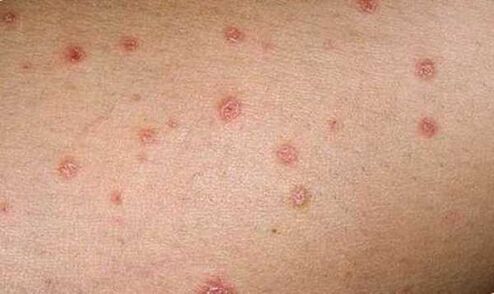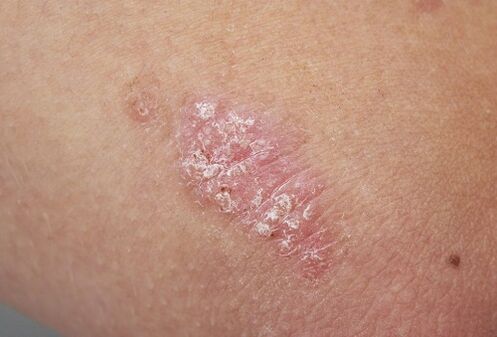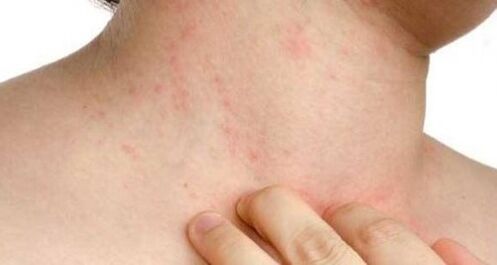A chronic disease lasts a long time, sometimes years - the almost complete disappearance of pathological symptoms can be replaced by a period of relapse, and then the body is covered with rash again. These are the hallmarks of psoriasis. In the early stages of the disease, it is important to know everything about the disease, including what psoriasis looks like, because the rapid detection and treatment of the disease depends on it.

Causes of the disease
The main factors in the development of the disease are a weak immune system that is unable to cope with genetic predispositions and functions transmitted from parents and close relatives.
This is a non-infectious lesion of the skin, so do not be afraid of infection by close contact with sick people. When something else is accompanied by scratching a disease that causes unpleasant, painful sensations and itching. By microscopic wounds and damage to the epidermis, any infection quickly enters the bloodstream and infects humans.
There are many known causes of diseases in medicine:
- Pathologies of the endocrine organs that cause hormonal changes;
- Constant stress, intense experiences, and concussions cause the same worries;
- Improper nutrition, nutrient, mineral and vitamin deficiencies can lead to psoriasis;
- Harmful habits, low immunity due to vitamin D3 and silicone deficiency, nervous shocks, frequent colds and hypothermia;
- Unfavorable living conditions and climate;
- Disruption of metabolic processes, especially in the skin, due to the fact that the disease takes the form of an itchy rash.
Medications can also cause anomalies, if they have a long course and a strong effect, the body's immune response to allergens can be an aggravating factor. Of course, the onset of psoriasis is often associated with infections that were previously completely untreated or have serious complications.
The defeat of the disease is local and general, the human body represents a continuous wound crust. In this regard, the stages of psoriasis are worth considering, as they differ in course and symptoms.
Types of diseases according to the nature of the course
The disease develops periodically - it is a gradual change and an increase in typical symptoms.

There are three main stages:
- Progressive psoriasisThere are two main stages. First, a characteristic rash actively develops, which causes the patient an unpleasant burning sensation, pain, severe itching. As a result, normal appetite and sleep are disturbed, and a person is currently prone to irritability, depression and neurosis. The second stage is remission, the restoration of the normal appearance and condition of the epidermis, pigmentation spots remain at the site of psoriatic lesions, slightly darker than normal skin color. The progressive stage is a typical clinical picture of a chronic disease. In the absence of treatment, rehabilitation periods are short and the pathology can be expected to worsen again soon;
- Stationary stage of psoriasis- It is a stable condition of the patient when these symptoms do not disappear, but new papules do not appear. At the same time, the growth of existing spots that are actively peeling is temporarily stopped. The patient hopes that the red plaques raised on the skin after peeling will heal and disappear, but this does not happen - one layer is formed after the corneum, and so on. Ad infinitum. At least in the stationary stage of psoriasis, the patient does not feel unbearable itching, scratching and insomnia;
- The last stage- regression period. Over time, the plaque-like crust gradually shrinks, the wounds heal, clean areas of the epidermis are visible until the rash is completely gone, leaving only residual pigmentation of the painful areas.
There is a long way to psoriasis. In some patients, complications occur most often in winter and autumn, in others the sun's rays worsen the condition, but there is a variant of non-seasonal exacerbations when relapse can occur at any time of the season. In general, there are several cases of disease development during the year.
To understand how psoriasis begins, it is worth considering its main symptoms.
Initial stage: characteristic manifestations
Pathology almost always appears suddenly, for no apparent reason, of course, exists. The shock may be a cold, stress at work, mild food poisoning, or an allergic reaction.
Many people are interested in how psoriasis manifests itself, because at first, small red nodules scattered in different parts of the body can be mistaken as evidence of allergy. If it is a pustular appearance, small purulent bubbles form on the epidermis, which can be easily confused with urticaria. Moreover, in some cases, the initial stage is accompanied by itching. Therefore, the question of whether psoriasis is itchy in the early stages with this type of skin lesion can be answered positively.
The main element of the rash is a flat, slightly raised pink or red nodule; on top of this inflammation there is a surface layer where small plates of dry, horny scales are located. Detailed research shows that first the stratum corneum is located in the center of the inflammatory focus and then grows on the entire surface of the plaque.

The location of the rash is different - these are the inner and outer wrinkles of the knee, elbow joints, the entire surface of the lower and upper extremities, hands, palms and soles of the hands, groin, gluteal region, back, chest. Elements of the rash tend to appear in the auricles and behind them, covering the scalp, everywhere on the face, and sometimes on the genitals, especially in men.
The rash elements scattered on the body grow with gray scab in just two or three days. In medicine, this is called a point form of the disease.
Later, new wounds continue to grow, after which they can merge and merge into solid areas. One of the features of the pathology is that if the disease begins to progress, the papules may be located at the site of caries and other injuries.
If the appearance of the first inflammation is usually not accompanied by itching, it becomes painful with a progressive course, and the patient needs to be treated with local hormonal drugs.
The onset of psoriasis can put the patient in a serious physical and mental condition.
Plaque growth prevents you from walking, sitting, and performing simple human movements. In addition, patients with this disease are prone to severe neurological and mental illness.
Some forms cause destruction of blood vessels, nerve endings, joints, psoriatic lesions can even destroy bone tissue. A person can become disabled without treatment, so you should consult a doctor in case of early manifestations of the disease.
Diagnosis and treatment
Prior to laboratory and instrumental examinations, the physician is tasked with obtaining a complete description of the patient's complaints, studying the causes of the disease, and tracking the genetic link with the onset of the pathology.
There is a certain functional test to diagnose the disease. If there is a stearin stain, a layer of pink cells, and three main elements (psoriatic triad) characterized by bleeding from vascular damage, then an accurate diagnosis can be made.

In the future, the following procedures:
- Biopsy of samples of affected skin tissue;
- Bacteriological culture to identify infection at the focus of inflammation;
- Clinical blood test for leukocyte concentration;
- Immunological test for allergic predisposition;
- X-ray, ultrasound to determine the condition of internal organs, joint cavities, bones;
- Differential diagnosis helps to rule out diseases such as syphilis, seborrheic eczema, pink lichen, rheumatism and other diseases with similar symptoms.
In most cases, it is not possible to permanently get rid of the pathology, but earlier treatment can help reduce the number and quality of relapses before long-term regression.
The complex treatment offers:
- Conservative therapy with steroids and non-steroidal drugs, psychotropic drugs that relieve the patient's depression;
- In addition, funds are prescribed to reduce the allergic reaction of the immune system, which allows to reduce the course of edema, itching and inflammatory processes;
- Hormonal medications are prescribed to suppress inflammation and relieve pain in severe forms;
- The patient should take vitamin products that help increase the body's defenses;
- Ointments and creams applied topically to improve the patient's well-being based on herbs and sometimes hormones.
People suffering from chronic skin disease need to lead a healthy lifestyle, avoid unhealthy foods and do water procedures every day to prevent the disease from getting worse. Of course, for successful rehabilitation you should consult a doctor as soon as possible.























